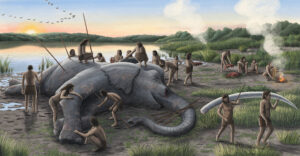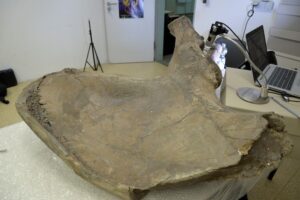
PROCEEDINGS OF THE NATIONAL ACADEMY OF SCIENCES—Researchers report evidence of widespread butchering of straight-tusked elephants by Neanderthals during the Last Interglacial Period. Previous analysis of faunal materials excavated at Neumark-Nord, Germany revealed evidence that Neanderthals hunted and butchered straight-tusked elephants (Palaeoloxodon antiquus) at the site for at least 2,000 years during the Last Interglacial Period, 125,000 years ago. However, how widespread such practices were among Neanderthals is unclear due to a dearth of evidence from other sites. Sabine Gaudzinski-Windheuser, Lutz Kindler, and Wil Roebroeks documented evidence* of straight-tusked elephant exploitation at two additional, contemporary Neanderthal sites at Gröbern and Taubach in Germany. Fossil P. antiquus remains from all three sites displayed cut marks distributed across the animals’ skeletons, consistent with butchering of entire carcasses to remove all edible meat, fat, and other tissues. A high fraction of individuals among the fossil assemblages were adults, suggesting that prime-aged individuals were preferentially targeted. The authors note that processing an entire adult straight-tusked elephant, which could weigh up to 13 metric tons, could provide more than 2,500 portions of daily calories. The results suggest that Neanderthals may have possessed the means to store large quantities of meat and fat, may have temporarily gathered in larger groups than previously recognized, or a combination of both explanations. According to the authors, Neanderthals on the North European plain routinely exploited straight-tusked elephants during the Last Interglacial Period.
_________________________

Artist’s reconstruction of a group of Neanderthals butchering a straight-tusked elephant (Palaeoloxodon antiquus). (It is unknown whether Neanderthals wore any type of clothing, so the depiction reflects artistic license) Credit: Alex Boersma/PNAS
_________________________

Pelvis of Gröbern elephant remains during inspection for cut marks. Image credit: Lutz Kindler.
_________________________
Article Source: PNAS news release.
*“Widespread evidence for elephant exploitation by Last Interglacial Neanderthals on the North European plain,” by Sabine Gaudzinski-Windheuser, Lutz Kindler, and Wil Roebroeks. Proceedings of the National Academy of Sciences, 4-Dec-2023. https://www.pnas.org/cgi/doi/10.1073/pnas.2309427120
_________________________
Advertisement

See the incredible archaeology, architecture, and art of northern Spain. A unique tour with special expert guides and lecturers through the collaboration of Popular Archaeology Magazine and Stone & Compass Tours. Not to be missed. Read More About It: https://popular-archaeology.com/article/northern-spains-triple-a-archaeology-architecture-and-art/.
_________________________



